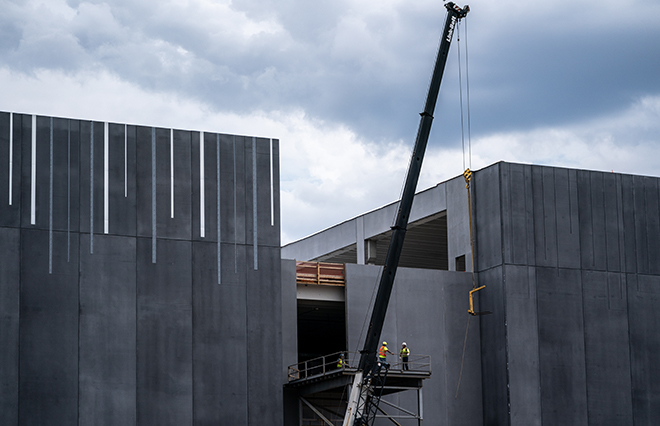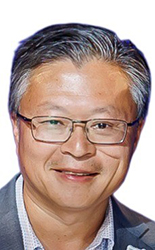Featured Topics
Featured Products
Events
S&P Global Offerings
Featured Topics
Featured Products
Events
S&P Global Offerings
Featured Topics
Featured Products
Events
S&P Global Offerings
Featured Topics
Featured Products
Events
Financial and Market intelligence
Fundamental & Alternative Datasets
Banking & Capital Markets
Economy & Finance
Energy Transition & Sustainability
Technology & Innovation
Podcasts & Newsletters
Financial and Market intelligence
Fundamental & Alternative Datasets
Banking & Capital Markets
Economy & Finance
Energy Transition & Sustainability
Technology & Innovation
Podcasts & Newsletters
10 Feb, 2025
By Siri Hedreen

| Construction crew working on a datacenter in Ashburn, Virginia, in July 2024. |
A serial entrepreneur who has sold energy ventures to Engie SA and BP PLC now seeks to help datacenter developers bypass the utility connection queue, drawing inspiration from IKEA Ltd.'s furniture kits.
Vic Shao's latest company, DC Grid Inc., promises a direct-current power kit capable of meeting the energy demands of artificial intelligence servers and electric vehicle fast-chargers.
The product is not an entirely new invention. While DC Grid designed the charging and power shelf components, the company plans to tap other vendors for natural gas generators and solar panels. But the main innovation is the all-in-one kit approach, promising reliable power generation in a matter of months, according to the founder and CEO.
"Furniture existed before Ikea, too," Shao said in an interview. "But Ikea made it so that you don't need to cut the wood to the right shape and sizes; you can just piece it all together very easily and quickly. That's how we think of ourselves."
Customers are not expected to assemble and operate the kit, Shao said. Instead, they would be paying for a service by the kilowatt-hour.
Previous ventures
DC Grid is not Shao's first foray into distributed power. In 2009, he founded Green Charge Networks, a battery storage company that was acquired in 2016 by the French utility Engie. Shao's second startup, Amply Power, provided EV charging services for trucks, transit, rental cars and other fleets. Oil major BP acquired Amply Power in 2021 and retained Shao to oversee the division.
Just before Shao left BP, he was leading about 60 construction projects with 20 different electric utilities.
 |
"Every single one of those was a service upgrade," Shao said. "You go to the utility; you ask them to bring more power. And time and time again the answer is four years, five years or in some cases, never."
The problem inspired Shao to start DC Grid in mid-2024, targeting hyperscalers and EV fleet owners unwilling to wait for grid power. The startup is not alone in this market. Enchanted Rock LLC, a natural gas microgrid company, and fuel cell manufacturer Bloom Energy Corp., are also targeting datacenter developers.
The difference with DC Grid lies in its use of direct-current power, according to Shao.
Ever since Nikola Tesla beat Thomas Edison in "the War of the Currents" in the late 19th century, the US power grid has predominately used alternating current (AC), which is easier to convert to higher and lower voltages.
But AC is less stable than DC, meaning that AI servers and fast chargers that require constant power must convert one to the other, resulting in some energy loss, Shao said. By skipping the round-trip conversion, DC Grid's equipment is 15-20% more efficient than alternatives, he added.
Meanwhile, engineers have gotten better at increasing or decreasing the voltage of DC. And since DC Grid plans to generate power at the point of consumption, the advantages of AC for carrying electricity long-distance are moot, Shao said.
The startup has yet to announce any customers. DC Grid signed a nonbinding agreement on Jan. 7 with fracking company Liberty Energy Inc. to use its mobile power generators, which run on gas or hydrogen. Until recently, Liberty Energy was headed by its founder Chris Wright, now US Energy Secretary for the Trump administration.
Shao proposes to power datacenters with a combination of gas-fired and renewable generation, depending on availability.
"We're not advocating for 100% gas," he said. "We're always going to try to bring in a mix ... because when it comes to several-hundred megawatts of datacenters, you need all the power sources that you can get."
Market for on-site power
Until recently, the conventional wisdom in the power sector was that datacenters would need ever more energy in the coming years. But the Jan. 27 release of DeepSeek, a Chinese AI model that appears to use far less electricity than its competitors, has rocked US tech companies and independent power producers.
Meanwhile, US President Donald Trump has criticized EVs and threatened to roll back subsidies.
Nevertheless, Shao expressed confidence that AI and transportation will continue to drive demand for power. He pointed to the Jevons paradox, a concept in economics that states that the less energy a technology uses, the cheaper it becomes, thereby widening its use and leading to even greater energy consumption.
"I think it's actually a very positive thing that the AI is becoming more efficient," Shao said.
As for EVs, Shao predicted that deployment will only increase over the next four years simply because drivers prefer it. The assertion is based on surveys Shao conducted at BP with electric truck users, including Amazon.com Inc. drivers who switched to Rivian Automotive Inc.'s delivery vans.
"I talked to a lot of them," Shao said. "100% of them told me they would never go back to gasoline or diesel. It's simply a better driving experience."